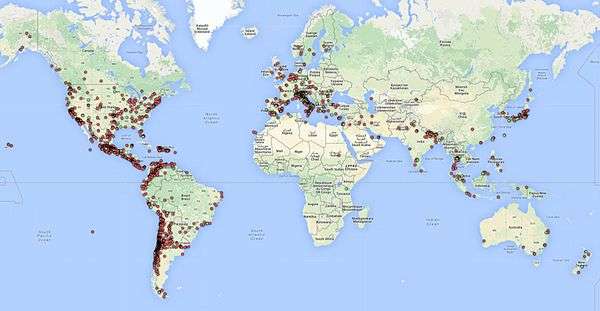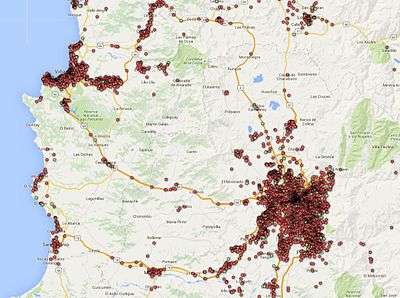Earthquake Network
|
| |
| Original author(s) | Francesco Finazzi |
|---|---|
| Developer(s) | Francesco Finazzi |
| Initial release | January 1, 2013 |
| Development status | Online |
| Project goal(s) | Smartphone-based earthquake early warning |
| Software used | Earthquake Network |
| Funding | In-app advertising |
| Operating system | Android |
| Available in | English, Spanish, Italian |
| Type | Volunteer computing |
| License | Proprietary |
| Active users |
|
| Website | Earthquake Network |
Earthquake Network[1] is a research project which aims at developing and maintaining a crowdsourced smartphone-based earthquake warning system at a global level. Smartphones made available by the population are used to detect the earthquake waves using the on-board accelerometers. When an earthquake is detected, an earthquake warning is issued in order to alert the population not yet reached by the damaging waves of the earthquake.
The project started on January 1, 2013 with the release of the homonymous Android application Earthquake Network. The author of the research project and developer of the smartphone application is Francesco Finazzi of the University of Bergamo, Italy.
Scientific research
Earthquake warning systems are intended to rapidly detect earthquakes in order to alert the population in advance. When an earthquake is detected, a potentially large amount of people who will be affected in locations not too close to the epicenter can receive the warning several seconds (10 to 60) before damaging shaking occurs. This is possible since the warning can be delivered at a higher speed than the speed of the earthquake waves. The Earthquake Network project focuses on developing an earthquake warning system using smartphones rather than professional seismometers.
Working principle
Smartphones with the Earthquake Network application installed are nodes of the sensor network of the Earthquake Network project. When a smartphone is not in use and it is connected to a source of power, the application switches on the accelerometer in order to read the smartphone acceleration. If a threshold is exceeded, the smartphone sends a signal to a central server. The server collects the signals sent by all the smartphones and, thanks to a statistical algorithm,[2] it decides in real time whether an earthquake is likely occurring. If an earthquake is detected, the server instantly notifies all the smartphones with the application installed. An alarm goes off when the notification is received, and the smartphone owner can take cover.

Network size and geographic distribution
The number of smartphones in the network is highly variable as users can install or uninstall the Earthquake Network application at any time. Additionally, the number of active smartphones (not in use and connected to a source of power) constantly changes during the day. Globally, the total number of smartphones with the application installed is around 129,000 (April 2016) and the number of active smartphones ranges from around 2,000 to around 8,000 depending on the hour of the day. The geographic distribution of the network nodes is given in the following table.


| Country | Nodes (%) |
|---|---|
| Ecuador | 41.4 |
| Chile | 31.9 |
| Mexico | 7.8 |
| Argentina | 2.7 |
| United States | 2.5 |
| Italy | 2.4 |
| Colombia | 2.3 |
| Peru | 1.3 |
| Others | 7.7 |
Detected earthquakes
From the beginning of the project, the smartphone network detected 239 earthquakes (April 26, 2016). Most of the earthquakes were detected in Chile where the network is quite stable in terms of number of smartphones. As an example, the magnitude 8.3 Illapel earthquake was detected by the smartphones in the city of Valparaíso. Smartphones in Santiago received the warning 10 seconds before the earthquake, while smartphones in Mendoza received the warning 20 seconds in advance.
Project development
The Earthquake Network project is expected to solve 4 main problems related to earthquake detection and location using a smartphone network.
Real-time detection
In order to be effective, the earthquake warning system of the Earthquake Network project is expected to detect the earthquake as fast as possible. Earthquake detection is performed by the real-time analysis of the data that the smartphone network sends to the central server. Since smartphones detect accelerations not necessarily induced by an earthquake, the server implements a statistical algorithm which is able to recognize real earthquakes from the background noise. The statistical methodology at the basis of the algorithm allows to control the probability of false alarm. Development stage: released.
Epicenter estimation
When detection occurs, it is important to obtain an estimate of the epicenter in order to locate the geographic areas that was affected by the earthquake. Two epicenter estimation algorithms for crowdsourced smartphone-based earthquake early warning systems have been developed and they are detailed in a paper[1] published on the Bulletin of the Seismological Society of America journal. Development stage: released.
Peak ground acceleration
The accelerations recorded by a dense smartphone network may be used to produce high resolution peak ground acceleration maps for the detected earthquakes. The task is complicated by the fact that smartphones are not secured to the ground and they are not directly measuring the ground acceleration. If properly calibrated, however, data from a large number of smartphones may allow to estimate the ground acceleration. Development stage: analysis.
Magnitude estimation
The earthquake magnitude is an important parameter as it defines the energy released by the earthquake event and it allows to evaluate the severity of the earthquake in terms of potential damages to property and people. Magnitude estimation using the data collected by the smartphone network is currently under study. Development stage: analysis.
References
- 1 2 Finazzi, Francesco (2016). "The Earthquake Network Project: Toward a Crowdsourced Smartphone‐Based Earthquake Early Warning System". Bulletin of the Seismological Society of America. doi:10.1785/0120150354. Retrieved 10 June 2016.
- 1 2 Finazzi, F.; Fassò, A. (2016). "A statistical approach to crowdsourced smartphone-based earthquake early warning systems". Stochastic Environmental Research and Risk Assessment. doi:10.1007/s00477-016-1240-8. Retrieved 31 March 2016.
External links
- Earthquake Network - The Earthquake Network project website
- Earthquake Network Android application - The Android application of the Earthquake Network project